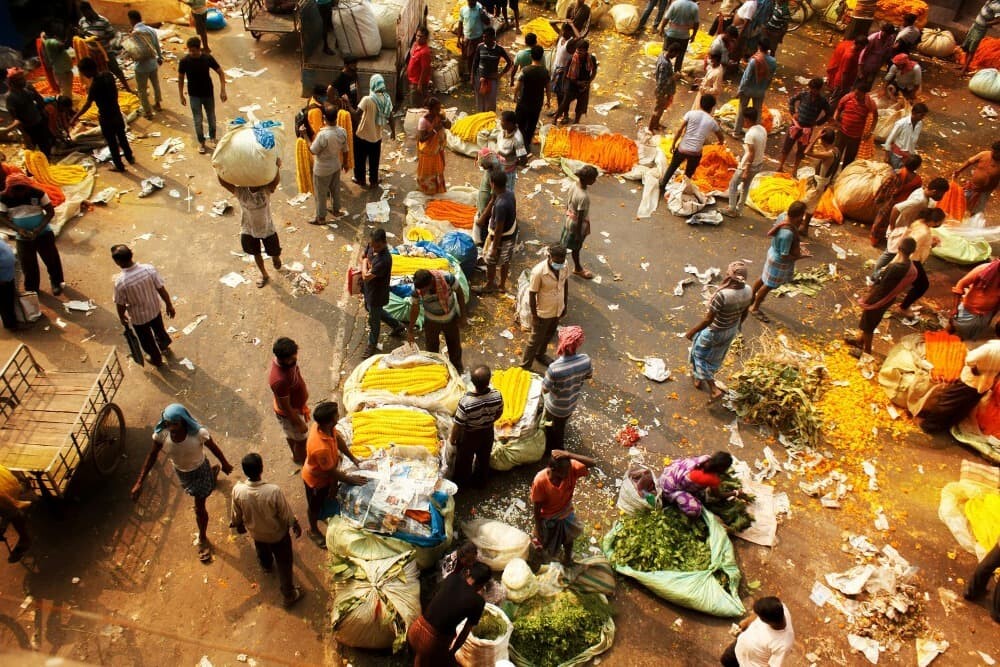Morocco is another incredible destination where you can live your volunteering experience. This country, located in the northwest of Africa, is known for its rich history, cultural and geographical diversity, and its strategic position at the gateway to Europe. Bordered by the Mediterranean Sea to the north, the Atlantic Ocean to the west, Algeria to the east and southeast, and the Western Sahara to the south, Morocco’s capital is Rabat, although its largest and most famous city is Casablanca.
Morocco’s history dates back to antiquity, with Berber, Roman, Arab, and later European influences, creating a multicultural and multilingual society that is reflected in all aspects of life, especially in its cuisine.
Today, we’ll explore some typical Moroccan dishes that you must try if you choose this country as your destination for an unforgettable journey.
TYPICAL DISHES
Couscous
One of the most emblematic dishes of Morocco, couscous consists of steamed wheat semolina served with a variety of vegetables, chickpeas, dried fruits, and often meat. It is traditionally prepared on special occasions.
The semolina is steamed in a special pot called a “couscoussier,” which has two parts: a lower section where the ingredients (meat and vegetables) are cooked, and an upper perforated section where the semolina is placed. As it cooks, the semolina is hydrated and cooked by the steam, giving it a fluffy texture.
Common meat options include lamb, chicken, beef, or even fish. The meat is slowly cooked with spices. Vegetables such as carrots, zucchini, turnips, squash, chickpeas, and onions are also included, and these are cooked along with the meat and seasoned with spices like cumin, turmeric, cinnamon, ginger, saffron, and paprika.
The broth in which the meat and vegetables are cooked is used to moisten the couscous, infusing the semolina with the rich and spiced flavors of the stew.
Couscous is served on a large plate, forming a sort of mound, with the vegetables and meat arranged on top. Some broth is then poured over the couscous to add flavor.
In some variations, raisins, toasted almonds, or chickpeas are added. Sometimes it is accompanied by a spicy sauce called harissa, which is offered on the side so that each person can adjust the level of spiciness to their taste.
Couscous symbolizes hospitality and community and is enjoyed in homes as well as festive celebrations.

Tagine
Another iconic dish in Moroccan cuisine, tagine is characterized by both its cooking method and the pot in which it is prepared, also called “tagine.” This dish combines meats, vegetables, dried fruits, and spices, all cooked slowly until the flavors meld together, and the ingredients become tender and aromatic.
The tagine pot is made of clay with a flat base and a conical lid, designed to allow steam to circulate during cooking, concentrating the flavors and maintaining the moisture of the ingredients. The conical lid traps the steam and redirects it downwards, helping to cook the food evenly.
Lamb is commonly used, as its meat becomes extremely tender when slow-cooked. Chicken is another popular option, often cooked with preserved lemon and olives. Beef or goat is also used, depending on the region, and fish is used in coastal areas.
Vegetables such as carrots, potatoes, zucchini, peas, eggplants, and tomatoes are added and placed at the base of the tagine, where they absorb the juices and flavors from the meat and spices.
Dried fruits like prunes, apricots, raisins, and almonds are also added, providing a sweet contrast to the saltiness of the meat and spices. Common spices include Ras el hanout, saffron, ginger, cumin, coriander, and turmeric.
Tagine is traditionally cooked slowly over coals, allowing the flavors to blend gradually. Nowadays, it can also be prepared in the oven or on a stovetop. It is important not to lift the lid frequently, as this interrupts the steaming process. The dish is served directly in the pot in which it is cooked, often accompanied by Moroccan bread for dipping in the sauce.
Tagine is a perfect dish to share with family or friends.

Harira
A traditional Moroccan soup, Harira is highly appreciated, especially during the holy month of Ramadan. It is a rich and hearty soup typically enjoyed when breaking the daily fast, though it is also enjoyed year-round.
Small pieces of lamb or beef are often used, along with lentils, a key ingredient that adds body and nutrients to the soup. Chickpeas are added after being soaked beforehand. The base of Harira is a tomato sauce, giving it its characteristic red color, made with fresh or pureed tomatoes.
The soup is seasoned with a mix of spices that can include ginger, turmeric, saffron, cinnamon, and black pepper. Fresh cilantro and parsley are also used to add a herbal touch.
To thicken the soup, a mixture of flour or semolina dissolved in water is added, giving it a creamier texture. Some variations include fine noodles or angel hair pasta, added towards the end of cooking. Sometimes beaten eggs are added at the end, creating filaments in the soup that enrich its texture.
The preparation begins by sautéing the meat in a pot with onion, garlic, and spices until browned. Then tomatoes are added and cooked until well mixed. Water or broth is added, followed by legumes (lentils and chickpeas) along with cilantro and parsley. The soup is cooked slowly for an hour or more, allowing the flavors to blend and the meat and legumes to cook through. After simmering for some time, the flour or semolina mixture is added to thicken it, and it continues to cook over low heat. If noodles are added, they are done so towards the end of the cooking process to avoid breaking apart.
The seasoning is adjusted with salt, and the beaten egg is added if used, stirring quickly to distribute the egg filaments.
Harira is served hot, usually accompanied by dates and a traditional Moroccan sweet called chebakia, a kind of honey and sesame fritter. It is often enjoyed as a single dish due to its richness and substance.
Depending on the region of Morocco, Harira can vary in its ingredients and consistency. Some versions may be thicker or include different types of meat. Every family has its own recipe, passed down from generation to generation.
Zaalouk
A traditional cooked salad commonly served as an appetizer or side dish, Zaalouk is primarily made of eggplants and tomatoes. It is known for its smooth texture and rich, smoky flavor, with a hint of spices.
Eggplants form the base of the dish and can be roasted, boiled, or fried before being mixed with the other ingredients. Fresh tomatoes, peeled and chopped, are cooked into a sauce that is mixed with the eggplants. Garlic is added, providing a potent and distinctive flavor.
The spices used include cumin, essential in Zaalouk, providing an earthy, deep flavor, sweet and spicy paprika, adding color and mild heat, depending on the amount used, and fresh cilantro and parsley.
Olive oil is fundamental in the preparation, used both for cooking and adding at the end, giving a smooth texture and rich flavor. Lemon juice is often added at the end to give a tangy touch that balances the flavors.
Eggplants are peeled (if desired) and mashed or chopped into small pieces. In a large pan, chopped garlic is sautéed in olive oil. Then the chopped tomatoes are added and cooked until they become a thick sauce. The cooked eggplants are then mixed with the tomatoes. Spices are added, and the dish is cooked over low heat, occasionally stirring, until all the ingredients are well mixed and the flavors have developed.
Zaalouk is typically served at room temperature or cold, accompanied by Moroccan bread (khobz) or as part of a selection of mezze (small dishes).
Other typical dishes include pastilla, a crispy filo pastry pie usually filled with pigeon or chicken meat, mixed with almonds, eggs, and spices, and sprinkled with powdered sugar and cinnamon; Mechoui, slow-roasted lamb, often cooked whole; and Briouats, small filo pastry pies filled with minced meat (usually lamb or chicken), almonds, and spices, which can be either sweet or savory.
Moroccan cuisine is characterized by its spiced flavors, making traveling to this country the perfect way to learn about its gastronomy.




